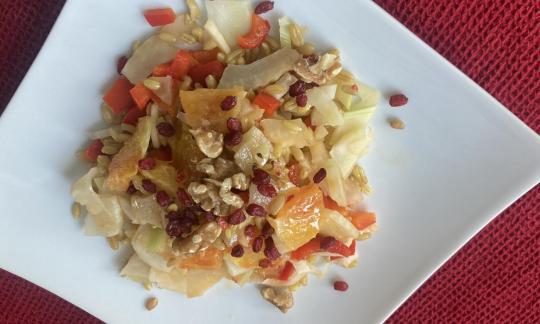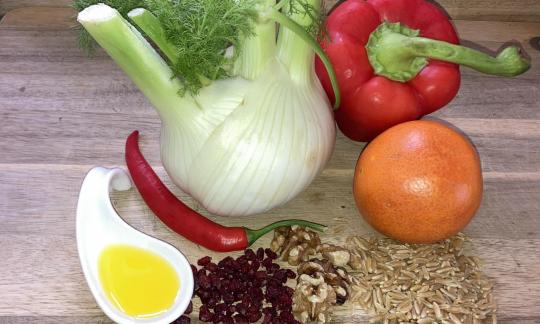Kamut salad with fennel and barberries
vegan
Ingredients (for servings, )
| For the salad | |
|---|---|
| 3 ½ oz | Kamut or Khorasan wheat, raw (organic?) |
| 200 ml | Drinking water, raw (organic?) (7.0 oz) |
| ½ large | Fennel (bulbs, raw, organic?) (9.4 oz) |
| ½ | Sweet peppers, red, raw (organic?) (2.9 oz) |
| ½ | Chili peppers, red, raw (organic?) (0.09 oz) |
| 1 tbsp | Rapeseed oil, refined (organic?) (0.49 oz) |
| For the dressing | |
| 1 ½ | Oranges, raw, (organic?) (6.9 oz) |
| 1 dash | Table salt (table salt, raw?, organic?) (0.01 oz) |
| ½ tsp | Mustard (Mostert, Mostrich, raw?, organic?) (0.09 oz) |
| topping | |
| ⅓ oz | Walnuts (tree nuts), raw (organic?) |
| ⅓ oz | Barberries, dried (organic?, raw?) |
Equipment
- stove
- citrus juicer (lemon squeezer)
- saucepan
Type of preparation
- cook
- chop or grind
- soak
- squeeze
- sweat
- season to taste
Preparation
Preparing Kamut
Cook the Kamut in water (according to the instructions). This takes about 50 minutes.Soaking: You can optionally soak Kamut for 8 hours or overnight before cooking and drain the water before cooking.
In the meantime, start with the next steps.
For the vegetables
Wash the fennel, cut into thin slices and then into thirds. Wash the pepper, remove the stalk and cut into cubes. Finely chop the chili. Sauté the fennel, pepper and chili in rapeseed oil or a little water for about 4 minutes.For the dressing
For 2 portions, peel and fillet 1 orange. Then squeeze ½ orange for the dressing. Mix the juice with all the other ingredients for the dressing.Completing the dish
Mix the kamut with the vegetables and dressing. Season with salt and chili. Sprinkle with orange segments, barberries and walnuts as a topping and serve.
|
Nutritional Information per person
Convert per 100g
|
2000 kcal | |
|---|---|---|
| Energy | 379 kcal | 19.0% |
| Fat/Lipids | 12 g | 17.0% |
| Saturated Fats | 1.1 g | 5.6% |
| Carbohydrates (inc.dietary fiber) | 63 g | 23.5% |
| Sugars | 23 g | 25.3% |
| Fiber | 14 g | 56.1% |
| Protein/Albumin | 11 g | 22.6% |
| Cooking Salt (Na:173.1 mg) | 440 mg | 18.3% |
| Essential micronutrients with the highest proportions | per person | 2000 kcal | |
|---|---|---|---|
| Vit | Vitamin C (ascorbic acid) | 123 mg | 153.0% |
| Vit | Vitamin K | 88 µg | 117.0% |
| Min | Manganese, Mn | 1.9 mg | 94.0% |
| Min | Selenium, Se | 43 µg | 78.0% |
| Elem | Potassium, K | 1'063 mg | 53.0% |
| Fat | Alpha-Linolenic acid; ALA; 18:3 omega-3 | 1.00 g | 50.0% |
| Min | Copper, Cu | 0.49 mg | 49.0% |
| Vit | Folate, as the active form of folic acid (née vitamin B9 and | 90 µg | 45.0% |
| Elem | Phosphorus, P | 294 mg | 42.0% |
| Vit | Thiamine (vitamin B1) | 0.42 mg | 39.0% |
Detailed Nutritional Information per Person for this Recipe
The majority of the nutritional information comes from the USDA (US Department of Agriculture). This means that the information for natural products is often incomplete or only given within broader categories, whereas in most cases products made from these have more complete information displayed.
If we take flaxseed, for example, the important essential amino acid ALA (omega-3) is only included in an overarching category whereas for flaxseed oil ALA is listed specifically. In time, we will be able to change this, but it will require a lot of work. An “i” appears behind ingredients that have been adjusted and an explanation appears when you hover over this symbol.
For Erb Muesli, the original calculations resulted in 48 % of the daily requirement of ALA — but with the correction, we see that the muesli actually covers >100 % of the necessary recommendation for the omega-3 fatty acid ALA. Our goal is to eventually be able to compare the nutritional value of our recipes with those that are used in conventional western lifestyles.
| Essential fatty acids | per person | 2000 kcal |
|---|---|---|
| Alpha-Linolenic acid; ALA; 18:3 omega-3 | 1.00 g | 50.0% |
| Linoleic acid; LA; 18:2 omega-6 | 3.8 g | 38.0% |
| Essential amino acids | per person | 2000 kcal |
|---|---|---|
| Tryptophan (Trp, W) | 0.09 g | 35.0% |
| Threonine (Thr, T) | 0.28 g | 31.0% |
| Phenylalanine (Phe, F) | 0.48 g | 31.0% |
| Isoleucine (Ile, I) | 0.35 g | 28.0% |
| Leucine (Leu, L) | 0.66 g | 27.0% |
| Valine (Val, V) | 0.44 g | 27.0% |
| Methionine (Met, M) | 0.16 g | 17.0% |
| Lysine (Lys, K) | 0.30 g | 16.0% |
| Vitamins | per person | 2000 kcal |
|---|---|---|
| Vitamin C (ascorbic acid) | 123 mg | 153.0% |
| Vitamin K | 88 µg | 117.0% |
| Folate, as the active form of folic acid (née vitamin B9 and | 90 µg | 45.0% |
| Thiamine (vitamin B1) | 0.42 mg | 39.0% |
| Niacin (née vitamin B3) | 4.8 mg | 30.0% |
| Vitamin B6 (pyridoxine) | 0.41 mg | 29.0% |
| Pantothenic acid (vitamin B5) | 1.2 mg | 20.0% |
| Vitamin A, as RAE | 141 µg | 18.0% |
| Vitamin E, as a-TEs | 2.0 mg | 17.0% |
| Riboflavin (vitamin B2) | 0.22 mg | 16.0% |
| Biotin (ex vitamin B7, H) | 5.0 µg | 10.0% |
| Essential macroelements (macronutrients) | per person | 2000 kcal |
|---|---|---|
| Potassium, K | 1'063 mg | 53.0% |
| Phosphorus, P | 294 mg | 42.0% |
| Magnesium, Mg | 113 mg | 30.0% |
| Sodium, Na | 173 mg | 22.0% |
| Calcium, Ca | 129 mg | 16.0% |
| Essential trace elements (micronutrients) | per person | 2000 kcal |
|---|---|---|
| Manganese, Mn | 1.9 mg | 94.0% |
| Selenium, Se | 43 µg | 78.0% |
| Copper, Cu | 0.49 mg | 49.0% |
| Zinc, Zn | 2.5 mg | 25.0% |
| Iron, Fe | 3.3 mg | 24.0% |
| Fluorine, F | 76 µg | 2.0% |
| Iod, I (Jod, J) | 1.6 µg | 1.0% |
The Kamut salad with fennel and barberries is easy to make and is very filling due to its high fiber content.
Nutrient profile: According to GDA guidelines, one portion of this high-fiber dish covers over 100% of the average daily requirement of vitamin C and vitamin K. Manganese and selenium are covered by a good 70%.
The ratio of omega-6 to omega-3 fatty acids is 4:1, which is below the maximum recommended ratio of 5:1.
You can find further information on this topic at the following link: Vegans often eat unhealthily. Avoidable nutritional errors.
Kamut: Kamut or Khorasan wheat is an old type of grain. It is a relative of today's wheat, not as overbred and mostly organic. The individual grain of this ancient wheat variety is about twice as large as the normal wheat grain and is more yellow.
Barberries: The dried barberry berries have a sweet and sour to tart taste. The shape is similar to that of raisins, but the berries are red and not brown, so they look similar to dried cranberries or dried goji berries. Barberries are mainly used in oriental cuisine.
Walnuts: The real walnut, also called tree nut, has the highest proportion of linolenic acid (an omega-3 fatty acid that is good for the heart) of all nuts. It also has health benefits thanks to tocopherols (forms of vitamin E) and many macro and trace elements.
Amount of salt: We have deliberately not given any information on the amount of salt, as individual needs vary greatly. You decide for yourself, but we recommend keeping the salt content as low as possible. It takes around 3 months to get used to a lower salt content, but you will also benefit from this change in terms of taste. You can find more information on this topic in the book we describe in detail: Salt Sugar Fat by Michael Moss.






